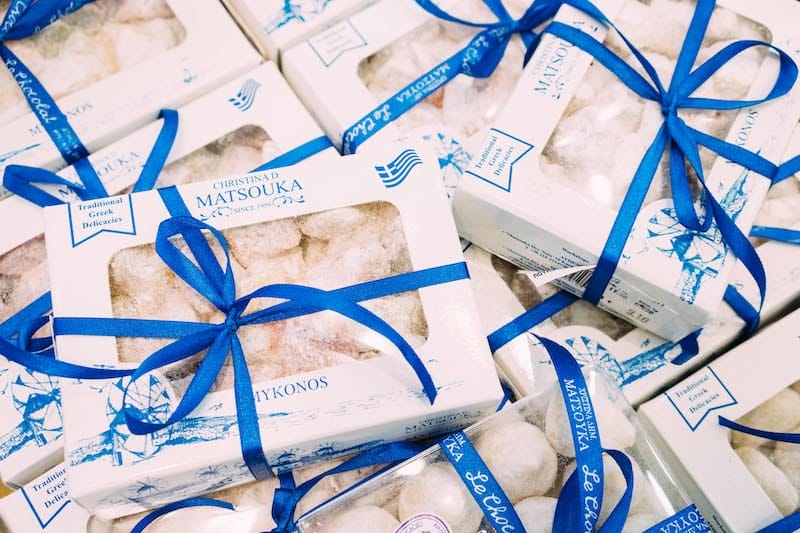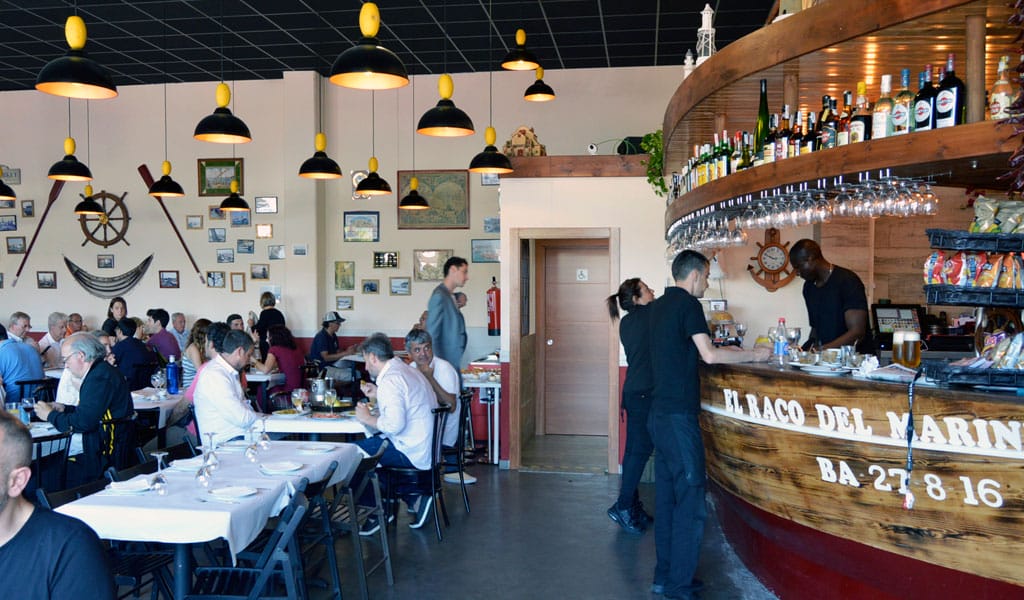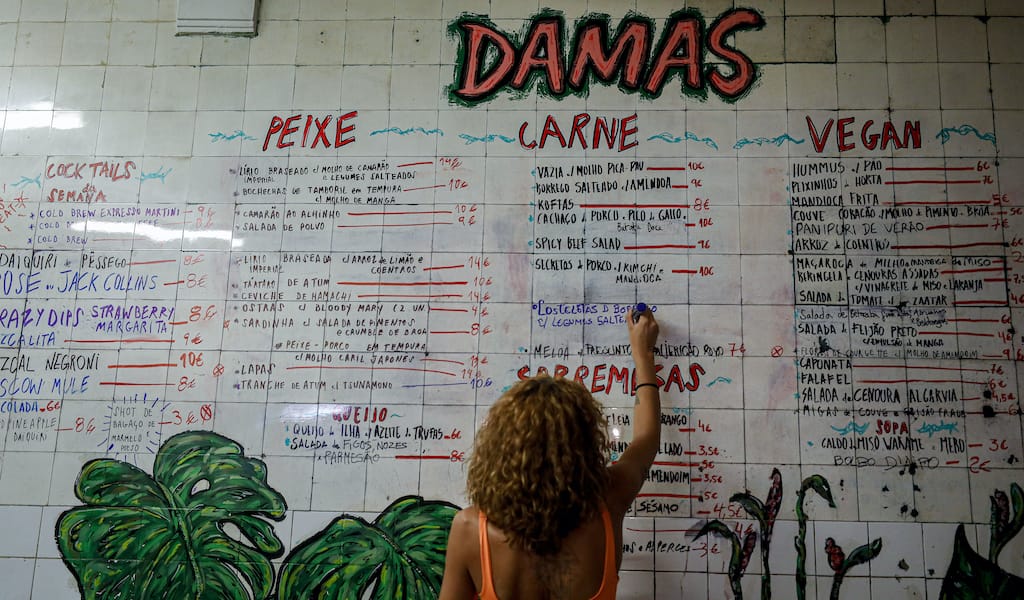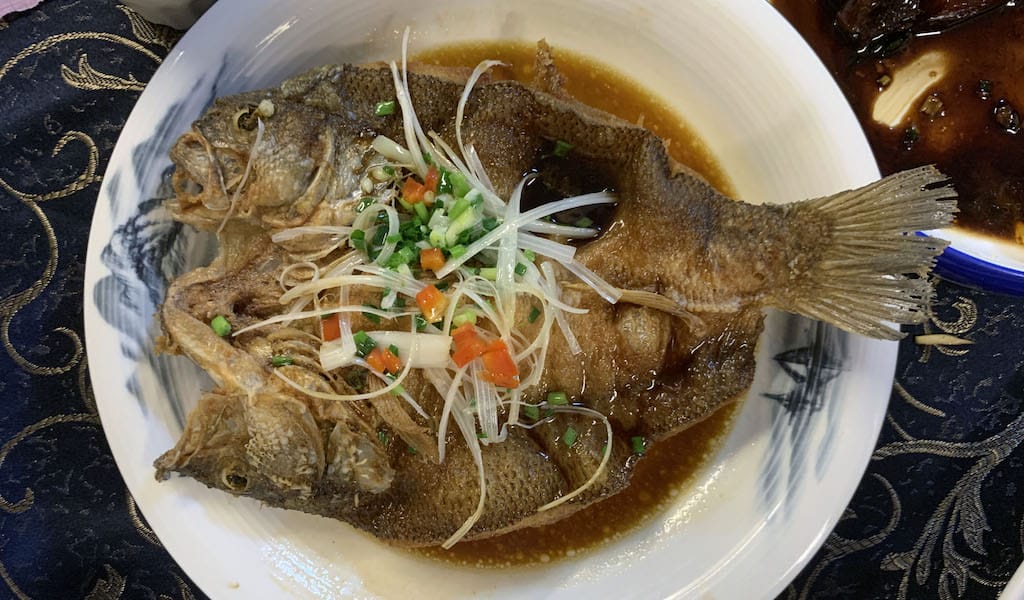Editor’s note: We are regret to report that Citrus is closed.
The resilient almond tree flourishes in a dry climate with very little water, which makes it an ideal tree for Greece, especially in the south and on many of the islands. So it’s no surprise that almonds have featured prominently in Greek cuisine and pastry making dating back to at least the 3rd century BC, or so historians believe. They became so closely associated with the region that they were even introduced to the Romans as nux Graecum (Greek walnut in Latin).
Today in Greece you’ll most likely find almonds in desserts or sweet treats. Since this particular nut generally symbolizes happiness, prosperity and good luck, it plays an important role in Greek weddings and baptisms, with sugared almonds and other sweets made with almonds, like amygdalota, being offered post-ceremony.
 Amygdalota in particular is a treat that symbolizes new beginnings. As its name suggests (amygdalo = αμύγδαλο, which means almond in Greek), this traditional sweet, which is similar in consistency to a cookie, is prepared with finely chopped or ground almonds (in some cases bitter almonds are also used) and sugar, and flavored with scented flower water (usually rose or orange blossom) or an essential oil like tangerine, vanilla or mastic. Egg whites and semolina are sometimes added in the recipe to create a denser texture. As a final touch, many are covered with a dusting of powdered sugar. One could say it is the Greek version of marzipan, although amygdalota differs both in flavor and texture.
Amygdalota in particular is a treat that symbolizes new beginnings. As its name suggests (amygdalo = αμύγδαλο, which means almond in Greek), this traditional sweet, which is similar in consistency to a cookie, is prepared with finely chopped or ground almonds (in some cases bitter almonds are also used) and sugar, and flavored with scented flower water (usually rose or orange blossom) or an essential oil like tangerine, vanilla or mastic. Egg whites and semolina are sometimes added in the recipe to create a denser texture. As a final touch, many are covered with a dusting of powdered sugar. One could say it is the Greek version of marzipan, although amygdalota differs both in flavor and texture.
Like many desserts in Greece, there are seemingly endless variations of amygdalota: The exact recipe, which determines their shape, texture and flavor, depends on the region from which they originate. The amygdalota made on the islands are particularly famous, especially those made on the Cycladic islands (Tinos, Mykonos, Sifnos, etc.) as well as on Lesvos, Chios, Hydra, Poros, Spetses and Skyros. Legendary are also the amygdalota prepared on Monemvasia, a small island located off the southeast shore of the Peloponnese.
Although sometimes baked or sun-dried, amygdalota are often uncooked. But just because they can be eaten raw doesn’t mean they’re unadorned: On the island of Tinos, they make a version of amygdalota called rodinia, in which the almond cookie is stuffed with either a morello cherry or a chestnut.
Amygdalota is a treat that symbolizes new beginnings.
While some of the best amygdalota are only available on the islands, several versions worth seeking out can be found in Athens:
Metropolitikon, a pastry shop near Syntagma Square (that also makes superb baklava), prepares three versions of amygdalota: Hydreika (from Hydra), Mandarinata and Sifneika (from Sifnos). Hydreika are traditionally made with blanched almonds, rose water and semolina. These bite-sized, pear-shaped cookies are not baked, and thus are moister. For the finishing touch, they are rolled in powdered sugar and crowned with a clove.
Mandarinata are also made with blanched almonds, flavored with Chios tangerine (a type of tangerine famous for its intense and unique aroma), covered in castor sugar and served unbaked. Sifneika are made with a mix of bitter almonds and unpeeled almonds, honey and orange blossom water, covered in powdered sugar and also served unbaked.

To taste amygdalota straight from Tinos or Mykonos, you should pay a visit to Matsouka, a beautiful shop near downtown’s Syntagma Square that sells different kinds of nuts and dried fruit as well as traditional treats, candies, chocolates and liqueurs made in Greece. They also offer versions of amygdalota from these two neighboring islands; both are larger in size and made with orange blossom water and egg whites. The treat is then covered in powdered sugar and baked slightly so as to form a thin layer of crust on the outside while still keeping the inside moist.
Citrus is a small deli specializing in products from the island of Chios, best known for its mastic production. Their Chios-style amygdalota are small, bite-sized and unbaked. They come in five different flavors – lemon, orange, Chios Tangerine bitter almond and, of course, mastic – and are available in small, sealed packets. We are partial to the tangerine-flavored version, which received a “Great Taste” award by the U.K. Guild of Fine Food in 2017.
An old family pastry shop based in Athens, Lonis specializes amygdalota and ergolavoi (a baked version, which slightly resemble French macarons) done according to recipes from the island of Hydra. What makes the Hydra-style amygdalota distinctive is the addition of rose water. Ergolavoi, on the other hand, are made with only powdered almonds, egg whites and sugar; because no aroma is added the natural flavor of the almond prevails. Larger in size than amygdalota, they are usually topped with a whole almond (no sugar coating) and baked, after which a thin layer of jam – usually apricot – is sandwiched in between two of the moist, chewy cookies.
Moving outside of the city center, Varsos is one of the most famous and historic pastry shops in wider Athens. Located in the northern suburb of Kifisia, it is best known for its exceptionally high quality sweets. Here they prepare three kinds of amygdalota: ergolavoi, rozetes (also made with rose water, from which it derives its name) and what they call Varsos-style: larger almond cookies flavored with orange blossom water, covered in powdered sugar and slightly baked.
Editor’s note: Our recurring Building Blocks feature focuses on foods and ingredients that are fundamental to the cuisines we write about.
 May 30, 2017 El Racó del Mariner
May 30, 2017 El Racó del Mariner
There are certain places that experience the strange phenomenon where everything and […] Posted in Barcelona August 8, 2022 Damas
August 8, 2022 Damas
At the end of Rua da Voz do Operário, the main road that leads up to the hilltop of the […] Posted in Lisbon January 28, 2022 Enter the Tiger
January 28, 2022 Enter the Tiger
Almost every Chinese holiday comes paired with a festive dish. At Tomb-Sweeping […] Posted in Shanghai
Published on November 07, 2017
Related stories
May 30, 2017
BarcelonaThere are certain places that experience the strange phenomenon where everything and nothing change at the same time. Take the example of El Racó del Mariner (The Sailor’s Corner), located for 40 years at the old fishermen’s dock in the port of La Barceloneta until it was forced to move when the area was turned…
August 8, 2022
LisbonAt the end of Rua da Voz do Operário, the main road that leads up to the hilltop of the previously sleepy Graça neighborhood, is a new, hip Lisbon kitchen that is reflecting the city’s growing hunger for great food and a good time. Damas, as the name indicates, is run by two women who…
January 28, 2022
ShanghaiAlmost every Chinese holiday comes paired with a festive dish. At Tomb-Sweeping Festival, there are bright green qingtuan (glutinous rice dumplings) to celebrate the arrival of spring. During Dragon Boat festival, we have zongzi, stuffed sticky rice steamed in bamboo leaves, to commemorate the poet Qu Yuan. And during Mid-Autumn Festival, we chow down on…


















































































